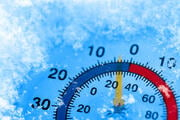 When most people think of cold stress, they think of frigid temperatures or blizzard-like conditions. Actually, cold stress occurs most often in the spring and fall, rather than winter. Four factors can contribute to cold stress: cold temperatures, high or cold wind, humidity, and cold water. A cold environment forces the body to work harder to maintain its temperature. Cold air, water, and snow all draw heat from the body. The wind chill is the combination of air temperature and wind speed. For example, when the air temperature is 40°F, and the wind speed is 35 mph, your exposed skin receives conditions equivalent to the air temperature being 11° F.
When most people think of cold stress, they think of frigid temperatures or blizzard-like conditions. Actually, cold stress occurs most often in the spring and fall, rather than winter. Four factors can contribute to cold stress: cold temperatures, high or cold wind, humidity, and cold water. A cold environment forces the body to work harder to maintain its temperature. Cold air, water, and snow all draw heat from the body. The wind chill is the combination of air temperature and wind speed. For example, when the air temperature is 40°F, and the wind speed is 35 mph, your exposed skin receives conditions equivalent to the air temperature being 11° F.
So, while it is obvious that below-freezing conditions combined with inadequate clothing could bring about cold stress, it is important to understand that it can also be brought about by temperatures in the 50's coupled with rain and wind.
The most common type of cold stress is hypothermia. Hypothermia means "low heat" and is a potentially serious health condition that occurs when body heat is lost faster than it can be replaced. When the body temperature drops below the normal 98.6° F to around 95° F, the onset of symptoms normally begins. The person begins to shiver and stomp feet to generate heat. As the body temperature continues to fall, slurred speech, lack of coordination, and memory loss develop and the person will stop shivering. Once the body temperature falls to around 85° F, the person may become unconscious, and at 78°, the person could die.
 Anyone working in a cold environment may be at risk for cold stress. However, older people may be at more risk than younger adults, because older people don’t generate heat as quickly as younger people. Certain medications, such as anti-depressants, sedatives, tranquilizers, and some heart medicines, may also prevent the body from generating heat normally.
Anyone working in a cold environment may be at risk for cold stress. However, older people may be at more risk than younger adults, because older people don’t generate heat as quickly as younger people. Certain medications, such as anti-depressants, sedatives, tranquilizers, and some heart medicines, may also prevent the body from generating heat normally.
 Planning for cold weather is the best way to stay safe. Wearing the correct clothing is extremely important, as is the type of clothing fabric. Cotton loses insulation when it becomes wet, but wool doesn’t.
Planning for cold weather is the best way to stay safe. Wearing the correct clothing is extremely important, as is the type of clothing fabric. Cotton loses insulation when it becomes wet, but wool doesn’t.
Guidelines for going out into the extreme cold:
- Wear three layers:
- An outer layer to break the wind and provide ventilation (nylon or other synthetics are good)
- A middle layer of wool or down to absorb moisture and provide insulation
- An inner layer of cotton or synthetic weave
- Wear a hat. Up to 40% of your body heat can be lost through your head
- Wear insulated footwear
- Keep dry clothes available for emergencies
- Do not wear tight clothing. Loose clothing provides better ventilation
Keep these points in mind as you head out into the cold and the wind, and stay safe.
Also, don't miss out on our FREE training videos covering a variety of OSHA-related safety topics. Check out our video library here.

-1.png)

